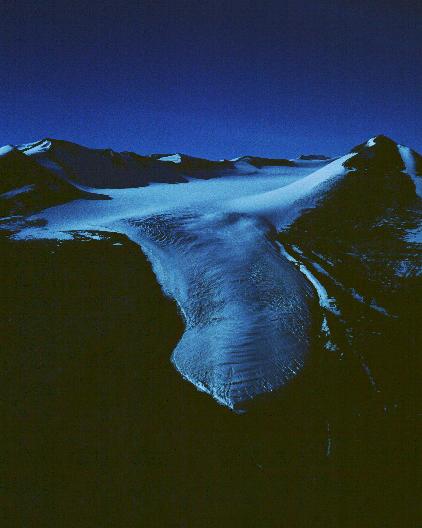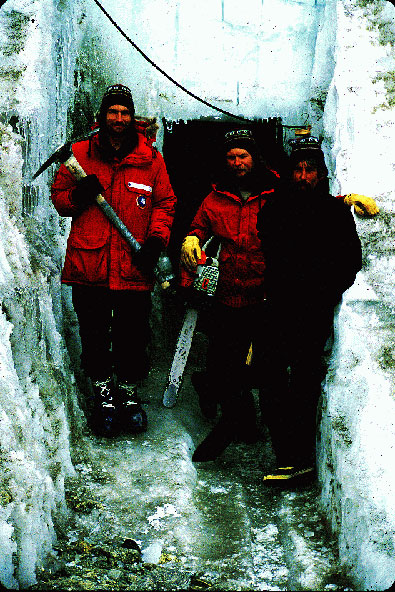Basal processes at subfreezing temperatures:
Meserve Glacier
revisited

|
Meserve Glacier (77o31'S, 162o17'E) is a cold-based
alpine glacier on the south side of Wright Valley, in Victoria Land, Antarctica.
It is located between Bartley Glacier and Hart Glacier. It was named by
Dr. Robert Nichols for William Meserve, who was a geological field assistant
to Dr. Nichols during the 1959-60 Antarctic field season.
|
Basal layers whose composition and mechanical properties differ
markedly from that of overlying ice exist beneath many cold-based
ice sheets and glaciers. Such layers have been observed
at the bottom of deep ice cores from the Arctic and Antarctic,
and at the margins and in tunnels beneath polar and sub-polar
glaciers.
The origin and rheological properties of these basal layers are
poorly understood. Yet accurate ice sheet flow modelling
requires knowledge of the viscosity and spatial extent of these
layers because deformations are strongest near the bed where
shear stresses are highest. Further, understanding the origins
of these layers could help in extracting paleoclimate records
from ice cores. For example, entrainment
processes are thought to be slow or non-existent at subfreezing
temperatures and it is not clear how a debris-rich basal layer
can form under these conditions. This raises the possibility
that the layers form by regelation or freeze-on under temperate
conditions which implies radically different conditions at the
bed in the past. Alternatively, if basal processes are active
at subfreezing temperatures, this would place a limit on how
close to the bed one could obtain an undisturbed stratigraphic
sequence for paleoclimate analyses.

|
During the 1995-96 field season we revisited the basal layers of Meserve
Glacier (Antarctica), a site first investigated by Gerald Holdsworth
and colleagues in the late 1960's. Meserve Glacier has a silt-rich
basal layer with a distinctive amber color. The basal temperature is
about -17oC. We used electric chainsaws, picks and shovels to
excavate a 30-m long tunnel into the tongue of the lower glacier.
Image: Kurt Cuffey (with pick), Tony Gades (with chainsaw) and
Howard Conway at tunnel entrance.
|
More pictures from the field here
Although not a perfect analogue for conditions under a large ice
sheet, the Meserve basal layer provides an excellent natural
laboratory for examining processes at subfreezing temperatures.
We measured diagnostic properties (stable isotopes, gases, solid and
chemical impurities, and crystal fabrics), as well as deformation.
Results showed that the chemical and solid impurity content of the basal
ice is 3-4x greater than the overlying glacier ice. Measurements from
strain grids installed on the tunnel walls indicate variations in shear
strain rate are at least partly correlated with impurity content.
An exciting early discovery was that Meserve Glacier is sliding (at least
locally) even though the basal temperature is -17oC. Cavities
in the lee of boulders imply active sliding, and most convincing, we
measured sliding directly (5-15 mm/yr) using displacement markers and
transducers. This and a related observation of ice segregation are
best explained as manifestations of unfrozen water films at ice-rock
interfaces. Using Shreve's theory for sub-freezing sliding, we estimated
the film thickness to be 20-40 nanometers (Cuffey et al, 1999).
In addition, our measurements of gas content and stable isotopes indicate
that entrainment processes are currently active beneath Meserve glacier
despite the cold temperatures. Subfreezing entrainment is facilitated by
the existence of interfacial water films, and associated sliding
(Cuffey et al, 2000a). The measurements were used to develop a simple model
describing the dependence of strain rate on ice crystal size and impurity
content. Results show a strong dependence on ice crystal size, suggesting
a grain-size sensitive deformation mechanism such as grain boundary sliding
is important. Chemical impurities act through a grain-size sensitive
mechanism, but do not dominate this component of deformation
(Cuffey et al, 2000b & 2000c).
Radio-echo sounding measurements on the lower glacier tongue and in the
upper accumulation basin reveal interesting bed morphologies. In the
upper reaches, both an over-deepening and a classical U-shaped trough
are indicative of glacial erosion, while the lower portion of the glacier
overlies a planar bed. It is still not clear whether the upper reaches
were eroded under cold conditions or whether conditions at the bed were
warmer in the past.
People involved in the project:,
Howard Conway, Kurt Cuffey, Tony Gades, Bernard Hallet, Nadine Nereson, Charlie
Raymond and Ron Sletten.
We also thank Bob Hawley, Living Nightingale, Kevin
Whilden and John Wright for their assistance in the field.
Publications and thesis
- Conway, H., K. Cuffey, A. Gades, B. Hallet, C.F. Raymond and R. Sletten, 1996. Observations of basal sliding at sub-freezing temperatures: Report on studies at Meserve Glacier, Antarctica. Antarctic Journal of the US, 31(2), 67-68
- Cuffey, K.M., 1999. Glaciological investigations beneath an active polar glacier. PhD thesis, University of Washington, 113pp.
- Cuffey, K.M., H. Conway, B. Hallet, A.M. Gades and C.F. Raymond, 1999. Interfacial water in polar glaciers and glacier sliding at -17oC. Geophys. Res. Letters, 26(6), 751-754
(pdf)
- Cuffey, K.M., H. Conway, A.M. Gades, B. Hallet, R. Lorrain, J.P. Severinghaus, E.J. Steig, B. Vaughn and J.W.C. White, 2000a. Entrainment at cold glacier beds. Geology, 28(4), 351-354
(pdf)
- Cuffey, K.M., H. Conway, A.M. Gades, B. Hallet, C.F. Raymond and S. Whitlow, 2000b. Deformation properties of subfreezing glacier ice: Role of crystal size, chemical impurities and rock particles, inferred from in situ measurements. J. Geophys. Res.105(B12), 27895-27915
(pdf)
- Cuffey, K.M., T. Thorsteinsson and E.D. Waddington, 2000c. A renewed argument for crystal size control of ice sheet strain rates. J. Geophys. Res. 105(B12), 27889-27894
(pdf)
Acknowledgements
The study was completed in 2000; the project was supported by the US
National Science Foundation (#OPP-9418381).
Any opinions, findings, and conclusions or recommendations expressed
in this material are those of the authors and do not
necessarily reflect the views of the National Science Foundation.
We also thank all those in the U.S. Antarctic Program who
provided outstanding logistical and science support, which was crucial to the
success of the project.
Return To Glaciology Project Page

